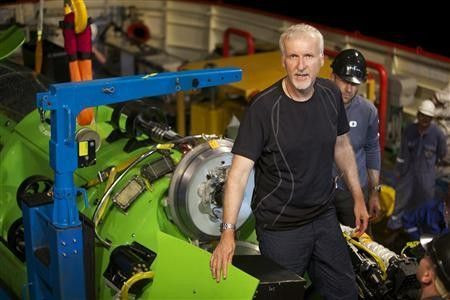James Cameron Dive: Video Of His Exploration Into The Mariana Trench Released [VIDEO]

National Geographic has released footage of James Cameron's trek 6.8 miles into the deepest section on the face of the Earth.
His solo dive into the Challenger Deep, part of the Mariana Trench in the western section of the Pacific Ocean, left Cameron feeling as he had was completely isolated from the rest of world, he said in the video. The video released shows just a few minutes of his three hour journey into the one of the last great frontiers.
I felt like I literally in the space of one day have gone to another planet and come back, said Cameron in the video, featured below.
Cameron descended into the great unknown with his custom designed vessel that was being constructed for the past seven years, the Deepsea Challenger.
The whole sub actually squeezes down three inches in length, just because of the pressure from the diving that far down into the Mariana Trench, said Cameron.
He described the trench as a vast frontier and a completely alien world that will take scientists and researchers several years to understand.
It was very lunar, very desolate place, said Cameron in the video. My feeling was one of complete isolation from all of humanity.
He spent more than three hours in the deepest part of the Mariana Trench, the Challenger Deep. He documented everything he saw, while taking samples of the ocean floor.
Unfortunately, Cameron did not see any fantastic sea creatures, like giant squids or other monsters from books and movies.
We'd all love to think there are giant squid and sea monsters down there, said Cameron, according to National Geographic.. We can't rule it out, but my bet is there aren't. What you're going to find is these very, very interesting animals, the likes of which we've never seen before, that have adapted to this extreme environment.
He did see saw some shrimp-like creatures. He described the animals as scavengers that eat dead fish or whales that sink to bottom of the ocean.
When I came to Challenger Deep, the bottom was completely featureless, he said, according to National Geographic. I had this idea that life would adapt to the deep ... but I don't think we're seeing that.
Cameron had planned to spend approximately six hours in the trench, but his trip was suddenly cut short due to mechanical issues. His submersible lost hydraulics and he was forced to resurface early.
It's a prototype vehicle, so it's gonna take time to iron out the bugs Cameron said of the glitch. The important thing is that we have a vehicle that's a robust platform - it gets us there safely, the lights work, the cameras work, and hopefully next time the hydraulics will work.
I lost hydraulics toward the latter part of dive, and I was unable to use the manipulator arm, Cameron said Monday morning, according to the National Geographic.
He said he sees this trip as the beginning of what is to come and the opening up this frontier to science and really understanding these deep places, he said according to National Geographic.
Cameron is the first person since 1960 to reach the deepest part of the Mariana Trench since the 1960s and he is the first person to explore the area alone.
[If the National Geographic video does not appear, please click here.]
© Copyright IBTimes 2024. All rights reserved.





















